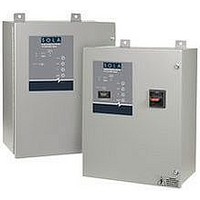STV 200K-27Y SOLA HEVI DUTY, STV 200K-27Y Datasheet - Page 37

STV 200K-27Y
Manufacturer Part Number
STV 200K-27Y
Description
Suppressor
Manufacturer
SOLA HEVI DUTY
Series
STV 200/400Kr
Datasheet
1.STC-CCTV-75.pdf
(40 pages)
Specifications of STV 200K-27Y
Suppressor Type
Transient Voltage
Voltage Rating
480V
Output Current
15A
Operating Voltage Range
277VAC To 480VAC
Peak Surge Current
200kA
Response Time
0.5ns
Connector Type
Wired
Protection Mode
L-N, L-G, N-G
Rohs Compliant
No
Lead Free Status / RoHS Status
Contains lead / RoHS non-compliant
Operating Characteristics of the CVS & MCR Series
Temperature
SolaHD’s ferroresonant power conditioners are very stable
with respect to temperature. The change in output voltage
is only 0.025%/°C. Units are factory adjusted to +2%/-0%
of nominal, with full load and nominal input voltage. This
adjustment to the high side of nominal is to compensate for
the natural temperature drift of about 1% that takes place
during initial turn-on or warm-up. When the unit warms up to
operating temperature, the voltage typically falls about 1%.
At a stable operating temperature, the output voltage will
change slightly with varying ambient temperatures. This shift
is equal to approximately 1% for each 40°C of temperature
change. The normal maximum temperature rise of a SolaHD
power conditioner may fall anywhere in the range of 40°C
to 110°C depending on the type and rating. The nominal
design ambient range is between -20°C and +50°C (-20°C
to +40°C for 70 - 1000 VA, 60 Hz portable models).
External Magnetic Field
In almost all applications, this effect may be disregarded.
The exclusive SolaHD “wide outside leg” construction (U.S.
Patent 2,806,199) reduces stray magnetic fields to a practi-
cal minimum. On critical applications, care should be taken
in orientation of the core with respect to critical circuits to
minimize the effect of the field.
Phase Shift
The phase difference which exists between input and
output voltages is in the range of 120 degrees to 140
degrees at full load. This phase difference varies with the
magnitude and power factor of the load, and to a lesser
extent, with changes in line voltage and load power factor.
Contact Technical Services at (800) 377-4384 with any questions.
Visit our website at www.solahd.com.
Power Protection and Conditioning
Transient Protection
Ferroresonant power conditioners protect input transients
(caused by lightning and load switching) from damaging the
sensitive electronic load. A typical surge protective device
(SPD) tries to ‘clamp’ a transient by diverting it to ground.
A ferroresonant power conditioner “blocks” the transient.
This ‘blocking’ action is achieved by total physical separation
from input (primary) to output (secondary). Because of
this difference in operation, it is difficult to apply the same
specifications to a ferroresonant power conditioner. Some
parallels can be made however.
One, is that under load, the let-through voltage of a
ferroresonant power conditioner (SPD refers to "clamping
voltage”) is less than 10 V above the point where the sine
wave would normally be at any given time. The ferroreso-
nant power conditioner is an ‘active tracking’ suppressor
with several advantages. The Ferro power conditioner will
not shunt the transient to the ground line as SPD devices
typically do. Shunting the transient to ground can cause the
disturbance to be transmitted to other sensitive loads within
a facility. This can pose serious problems with electronic or
microprocessor-based equipment, especially if there is poor
grounding within a facility. Other advantages provided by fer-
roresonant power conditioners include noise filtering, filtering
of harmonic distortion and protection against voltage fluctua-
tions such as sags or swells. These features are not provided
by standard surge protection devices but are often
misrepresented or misused by SPD manufacturers trying to
market their product as a “Do All” power quality device.
45
















